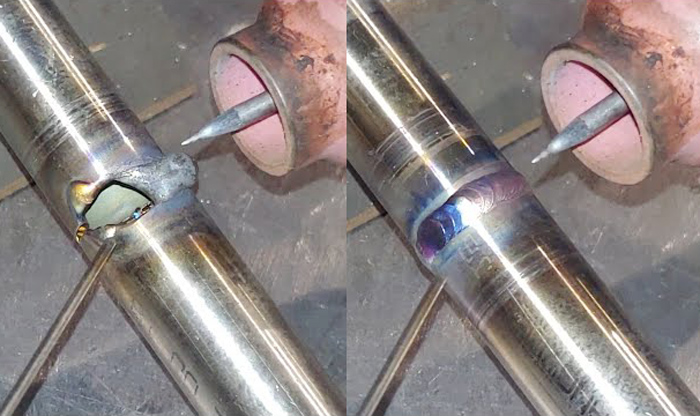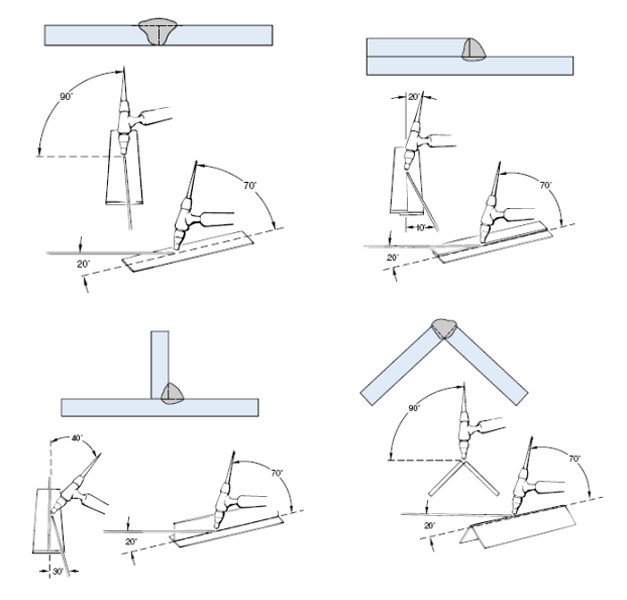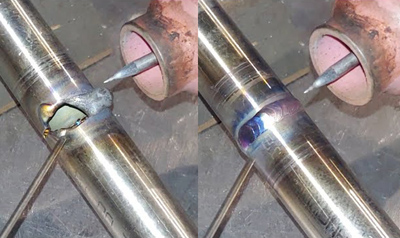Are you ready to embark on a journey into the intricate world of TIG welding? As a beginner, mastering TIG welding can be both exhilarating and daunting. This comprehensive guide is designed to equip you with expert tips and tricks tailored specifically for beginners, ensuring a seamless transition into the realm of precise and clean welds. From selecting the right equipment to perfecting your technique, we’ve got you covered.
Let’s dive into the secrets that will enable you to strike the perfect balance between amperage and torch angle, empowering you to elevate your welding prowess. With these insights, you will gain the confidence to tackle intricate projects and conquer common challenges, setting you on the path to flawless welds in no time.

What is TIG Welding?
Tungsten Inert Gas (TIG) welding is a versatile and precise welding process that utilizes a non-consumable tungsten electrode to create the weld. This type of welding is known for producing high-quality, clean welds on a variety of materials, including stainless steel, aluminum, and exotic metals. TIG welding offers greater control over the welding arc and heat input, making it suitable for welding thin materials and achieving intricate weld joints.
The process involves the use of a shielding gas, typically argon, to protect the weld pool from contamination, resulting in strong, visually appealing welds with minimal spatter and distortion. TIG welding is widely favored in industries such as aerospace, automotive, and fabrication for its precision and aesthetic appeal.
As with any welding process, TIG welding presents its own set of advantages and challenges. One of the key advantages of TIG welding is its ability to produce high-quality welds with minimal post-weld cleanup. The precise control over the welding arc allows for welding thin materials without distortion, making it suitable for applications where aesthetics and structural integrity are paramount. Additionally, TIG welding permits welding on a wide range of metals, including stainless steel, aluminum, copper, and titanium, offering versatility across various industries and applications.
TIG welding also comes with its challenges, including a steeper learning curve compared to other welding processes. Mastering the coordination of torch movement, filler metal addition, and foot pedal control demands practice and patience. Furthermore, the process can be slower than other welding methods, requiring a steady hand and careful attention to detail.
Essential TIG Welding Equipment
Before diving into TIG welding, it’s essential to ensure that you have the necessary equipment to support your welding endeavors. The core components of a TIG welding setup include a TIG welder, TIG torch, tungsten electrodes, shielding gas, filler metal, and personal protective equipment (PPE). When selecting a TIG welder, consider factors such as amperage range, duty cycle, and AC/DC capabilities based on the materials you intend to weld. A high-frequency start and pulse feature can enhance welding performance, especially for thin materials and intricate welds.
The TIG torch, equipped with a collet, collet body, gas lens, and ceramic cup, plays a crucial role in controlling the shielding gas flow and maintaining a stable welding arc. Tungsten electrodes come in various compositions, with thoriated, ceriated, lanthanated, and pure tungsten being common options, each offering unique benefits for specific welding applications.
TIG Welding Settings
Setting up your TIG welding workspace is paramount to ensuring a safe and efficient welding environment. Begin by establishing a well-ventilated area to minimize exposure to welding fumes and gases. A sturdy welding table or workbench with a non-flammable surface provides a stable platform for welding and facilitates proper workpiece positioning. Organize your welding accessories, such as filler metal, tungsten electrodes, and welding clamps, within easy reach to streamline your welding process.
Ensure that your welding area is equipped with essential safety equipment, including a fire extinguisher, first-aid kit, and adequate lighting. Implementing a dedicated space for TIG welding not only enhances safety but also promotes organization and efficiency in your welding operations.
TIG Welding Techniques for Beginners
As a beginner in the world of TIG welding, mastering fundamental welding techniques is crucial for laying a strong foundation. Start by familiarizing yourself with the proper torch angle and travel speed to achieve consistent and uniform weld beads. Maintaining a consistent distance between the TIG torch and the workpiece is essential for controlling the heat input and ensuring proper shielding gas coverage. Experiment with various torch angles and travel speeds to find the optimal settings that yield clean and well-penetrated welds.
Practice controlling the amperage using the foot pedal or machine settings to modulate heat input based on the material thickness and welding position. Achieving a steady and controlled weld pool is key to producing high-quality TIG welds, and honing these fundamental techniques will set the stage for your welding journey.
While embarking on your TIG welding endeavors, it’s important to be mindful of common welding mistakes that beginners often encounter. One of the primary challenges is maintaining a consistent torch angle and travel speed throughout the welding process. Inconsistent torch manipulation can result in uneven weld beads, lack of fusion, or excessive heat input, leading to distortion and burn-through. Another common pitfall is improper filler metal manipulation, such as feeding the filler rod too quickly or erratically, resulting in irregular and discontinuous welds.
Overlooking proper cleaning and preparation of the workpiece, including removing surface contaminants and oxide layers, can compromise weld quality and integrity. By recognizing these common mistakes and practicing corrective techniques, you can elevate your TIG welding proficiency and produce exceptional welds.

TIG Welding Safety Precautions
Prioritizing safety is paramount in TIG welding to mitigate potential hazards and ensure a secure welding environment. As a TIG welder, it’s imperative to wear appropriate personal protective equipment (PPE) to safeguard against arc radiation, sparks, and fumes. This includes a welding helmet with a designated shade for TIG welding, flame-resistant welding gloves, protective clothing, and closed-toe leather boots. Additionally, respiratory protection, such as a respirator or welding fume extractor, is essential to minimize inhalation of welding fumes and airborne contaminants.
Implementing proper ventilation, whether through natural airflow or mechanical ventilation systems, aids in dissipating welding fumes and maintaining air quality within the welding space. Regular maintenance and inspection of welding equipment, including the TIG welder, torch, and gas supply, are crucial to ensuring operational safety and preventing potential malfunctions.
TIG Welding Tips for Improving Precision and Quality
Elevating your TIG welding skills to achieve precision and superior weld quality requires a combination of practice, technique refinement, and attention to detail. Start by optimizing your welding parameters, including amperage, gas flow rate, and tungsten electrode type, to suit the specific material and joint configuration. Maintaining appropriate gas coverage and shielding gas flow is critical to preventing oxidation and ensuring a clean weld appearance.
Experiment with different tungsten electrode diameters and compositions to find the most suitable option for your welding applications, considering factors such as arc stability, electrode life, and contamination resistance. Refining your filler metal manipulation techniques, such as consistent feeding and proper rod angle, contributes to producing aesthetically pleasing and structurally sound welds.
As you progress in your TIG welding journey, consider incorporating advanced techniques to further enhance your welding capabilities. TIG welding offers the flexibility to employ advanced methods, such as pulse welding, back purging, and welding in various positions, to tackle complex projects and achieve superior weld integrity. Pulse welding, for instance, enables precise heat control and reduced heat-affected zones, making it suitable for thin materials and heat-sensitive applications.
Back purging, using an inert gas to shield the backside of the weld joint, minimizes oxidation and improves weld penetration, particularly in applications requiring weld integrity on both sides of the material. Mastering welding in different positions, including overhead and vertical welding, expands your versatility and prepares you to tackle a diverse range of welding scenarios with confidence.
Final Thoughts
Delving into the world of TIG welding tips and tricks as a beginner opens the door to a realm of precision, creativity, and craftsmanship. Equipped with a solid understanding of TIG welding fundamentals, essential equipment, safety precautions, and advanced techniques, you are poised to embark on a fulfilling welding journey. By honing your TIG welding skills and embracing the tips and tricks outlined in this guide, you will not only conquer common challenges but also unleash your potential to create flawless welds with finesse.
Whether you are fabricating intricate components, welding exotic metals, or embarking on artistic endeavors, TIG welding empowers you to fuse your vision with precision and artistry. Embrace the journey, embrace the art of TIG welding, and let your creativity flow with every immaculate joint you create.
This comprehensive guide serves as your compass, guiding you through the intricacies of TIG welding and illuminating the path to mastery. As you venture into the world of TIG welding, remember that practice, perseverance, and continuous learning are the cornerstones of refining your craft. Embrace each weld as an opportunity to elevate your skills and breathe life into your creations with the artistry of TIG welding.
